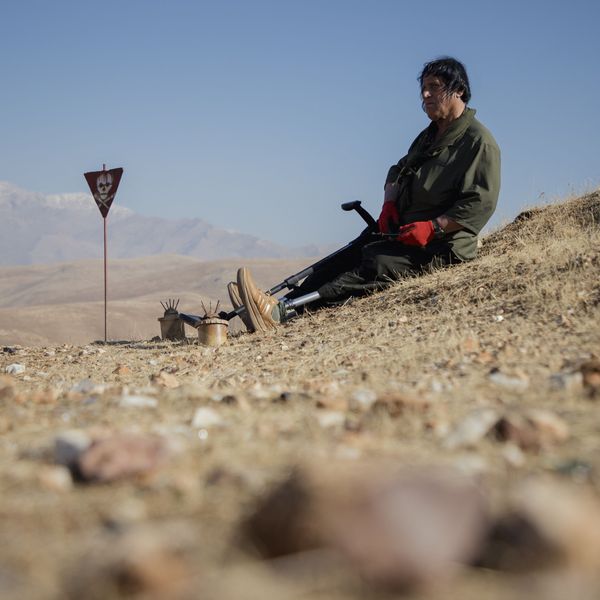MANAGUA - Military sources in Nicaragua and Organisation of American States (OAS) officials warned that dozens of minefields remain live and dangerous in this country -- a legacy of the 1981-1990 civil war.
Carlos Orozco, regional coordinator for the OAS Assistance Programme for Demining in Central America (PADCA), told IPS that 51 minefields have been discovered in the border zone with Honduras, an area where about 24,000 campesinos (small farmers) live.
This area was the theatre of war between the so-called "contra fighters", irregular rightwing forces organised and financed by the United States, and the Sandinista People's Army (EPS), the government armed forces, reorganised after the leftwing Sandinista guerrillas overthrew the decades-old dynastic dictatorship of the Somoza family in 1979.
According to official statistics, 50,000 people died, 500,000 were displaced from their homes and around 50,000 were seriously injured during the war against the contras.
Orozco said that the army laid 135,000 anti-personnel landmines. The number of mines laid by the contras, mainly in areas bordering Costa Rica and Honduras, is unknown.
The OAS programme's records show that at the end of the war, the Nicaraguan army had a stockpile of thousands of tons of explosives and 133,435 landmines, which were systematically destroyed by 2002.
"In 1990, there were 500,000 Nicaraguan civilians living less than 10 kilometres from minefields," said Orozco.
Over the last five years, complaints from campesinos in the provinces of Jinotega and Nueva Segovia, bordering on Honduras, as well as from Matagalpa, northeast of Managua, alerted the military authorities to explosions occurring in these mountainous areas.
An army investigation uncovered minefields in the vicinity of former contra military camps.
Staff in charge of the OAS programme identified eight municipalities with a total at-risk population of over 24,000 people living within five kilometres of the minefields.
The inspector general of the Nicaraguan army, Major General RamAfA3n Humberto CalderAfA3n, told IPS that this year the armed forces plan to begin clearing the 51 remaining minefields left by the civil war, under the National Humanitarian Demining Programme.
The armed forces estimate that there are about 17,000 mines. They intend to destroy 7,600 this year and the remainder in 2009, if funding can be secured.
Army chief General Omar Halleslevens said that since the beginning of mine clearing operations, a total of 157,972 anti-personnel mines had been destroyed.
Approximately 1.1 million people have benefited directly or indirectly from the clearing of 397 minefields, military authorities said.
"Around my village there were over 15,000 mines. Many people were killed, and others left the village because of poverty, as no one would go into those deadly fields to plant crops. Now there are roads and schools where there used to be buried bombs," said Agresio Osejo, mayor of Somotillo, a municipality in Chinandega province in the west of the country.
According to the Nicaraguan army, since 1990 they have cleared minefields on agricultural land, as well as 145 kilometres of roads in the northern border zone and 96 kilometres along the southern border.
In spite of the progress, retired Colonel William McDonough, head of Humanitarian Demining at the OAS, does not believe that Nicaragua will be declared landmine-safe in 2009 as had been hoped in 2005, when 90 percent of the mines were thought to have been eliminated.
"The remaining 51 minefields are the most remote and inaccessible. The army won't be able to destroy them in two years," McDonough, who has been supervising demining operations in Latin America since the late 1980s, told IPS.
McDonough is concerned about the cessation of funding by Denmark and Sweden for Nicaragua's demining operations. Aid from these countries ended in December.
However, Canada, the United States, Japan and European Union countries are continuing to fund landmine clearance, said Orozco.
But in his view, more resources will be needed to eliminate the recently discovered minefields, as even the OAS is facing budgetary constraints.
"We have about 1.5 million dollars to carry out our demining plans for 2008, but we need another 3.7 million dollars for demining in 2009, and to continue the victim aid programme until 2010," Orozco said.
The OAS has a waiting list of 100 maimed landmine survivors in need of rehabilitation, he added.
"We have already completed the diagnoses of 98 disabled people, and we hope to train them in productive work this year so that they can be integrated as useful members of society, but we need extra resources to do this," said Orozco.
Since the victim aid programme began in 1990, 1,187 people have survived mine explosions, while another 50 have died.
The Defence Ministry's National Demining Commission reported that in 2007 alone, it provided care for 425 survivors.
"A total of 1,250 consultations took place with people needing ongoing treatment, who came to have their prosthetic limbs changed, undergo eye and ear operations and receive psychological help, or other interventions," the Commission said.
Oswaldo Danilo Mairena, a 45-year-old former soldier, is one of the people being treated by the demining authorities.
He lost his left leg and left eye in 1991 while attempting to deactivate a landmine. Nearly 17 years later, the ex soldier still requires medical treatment for his injuries.
"When you trigger a landmine, you go on bleeding forever," Mairena said.
(c) 2008 Inter Press Service


